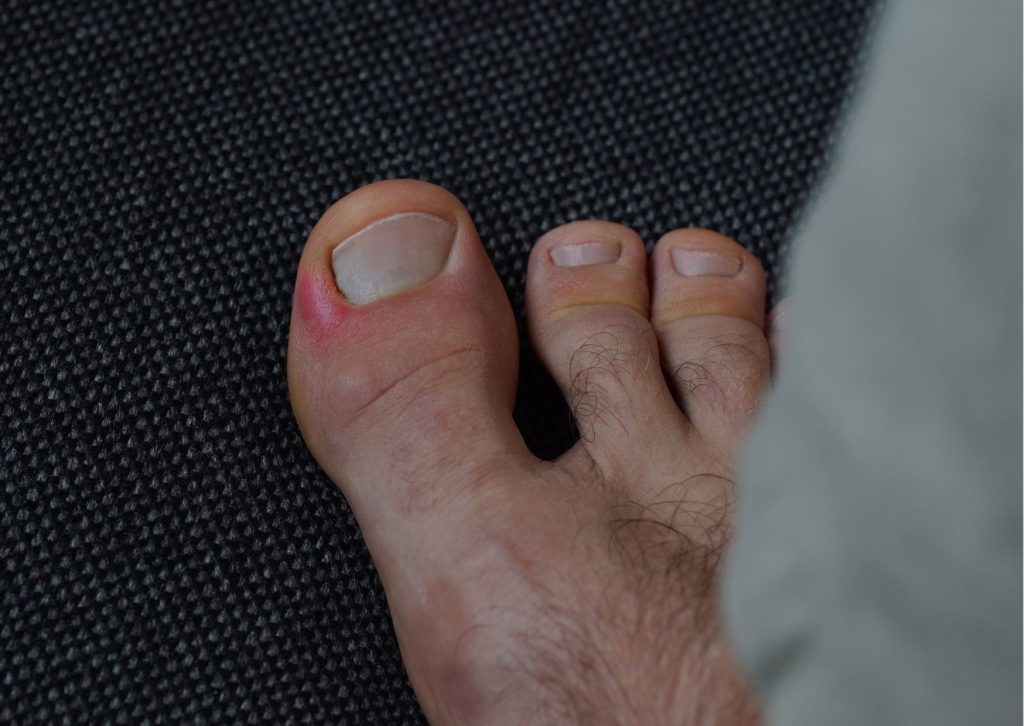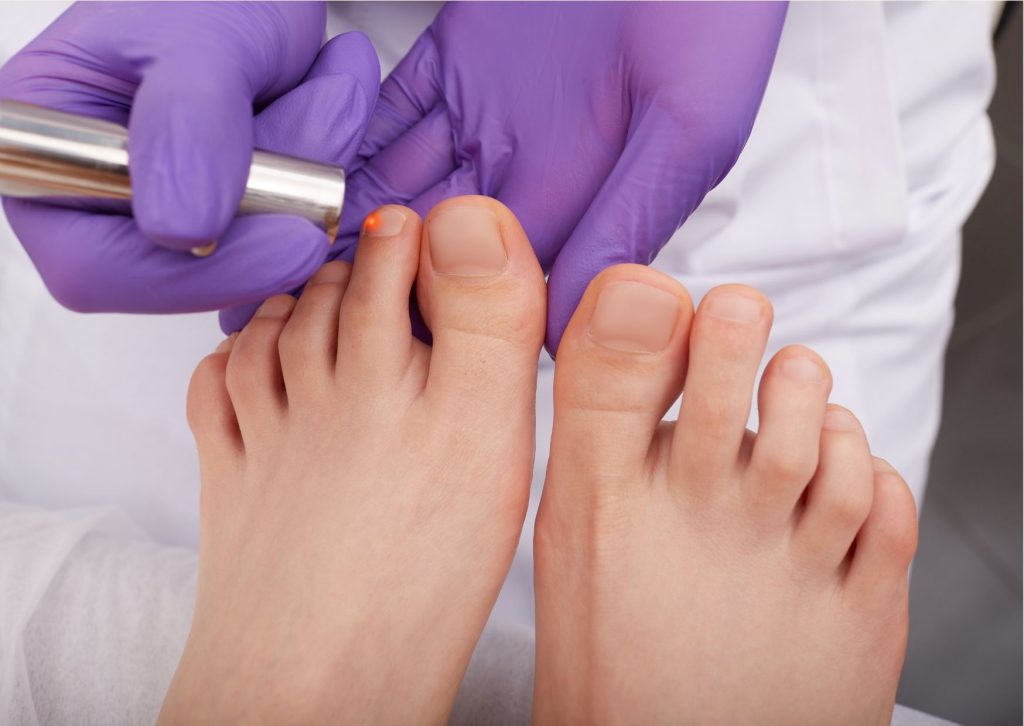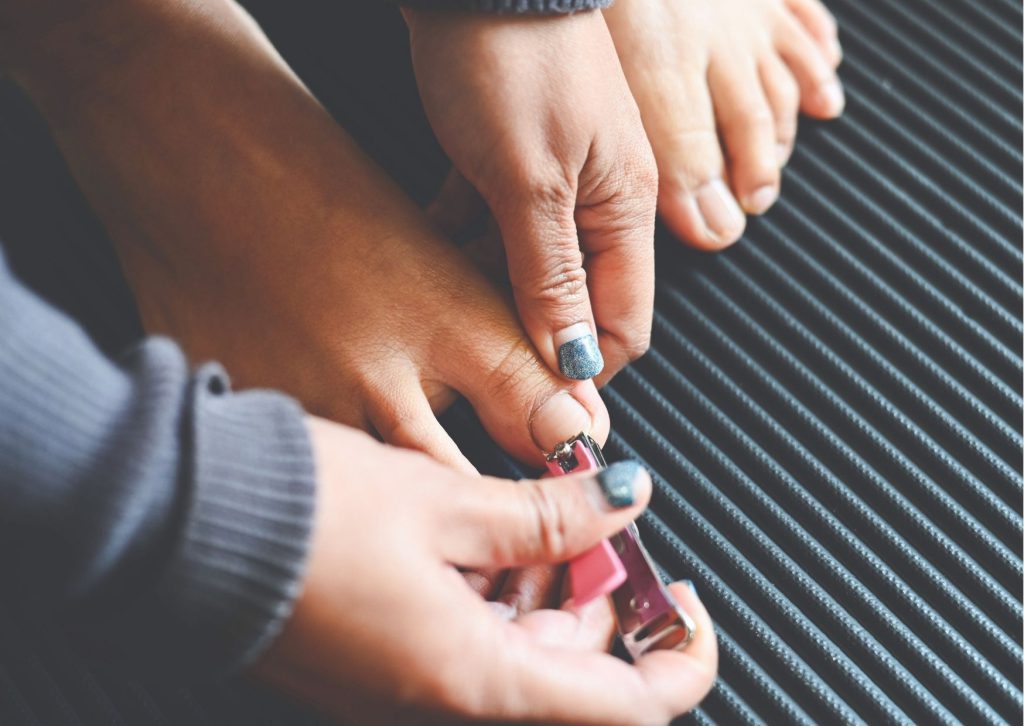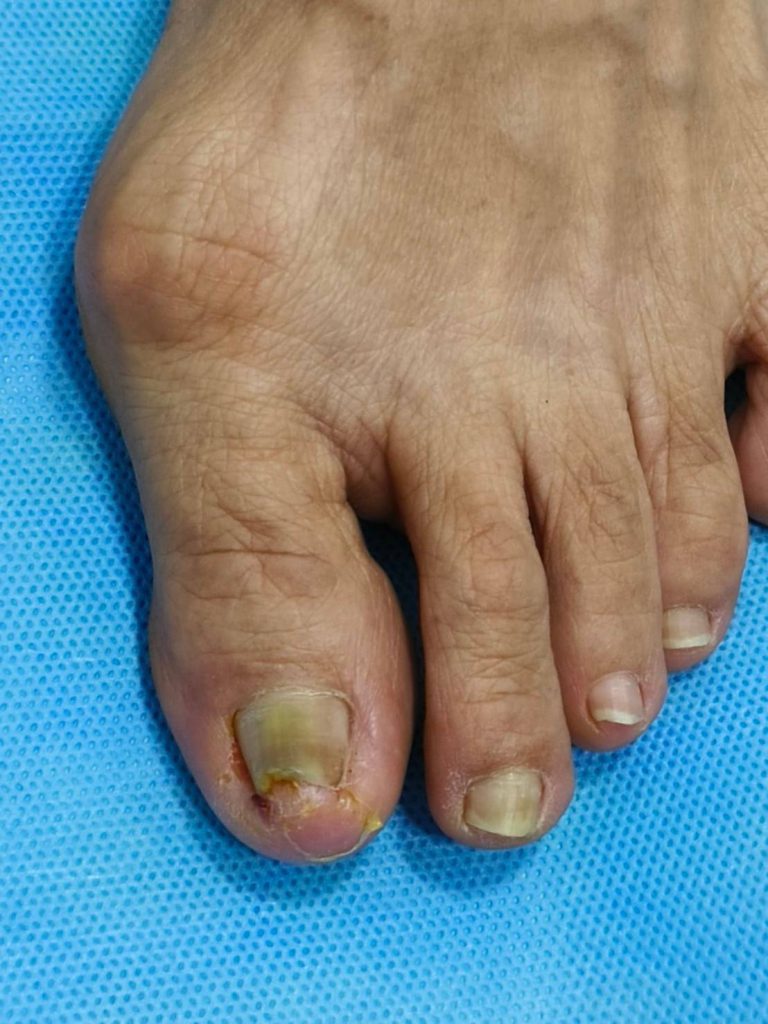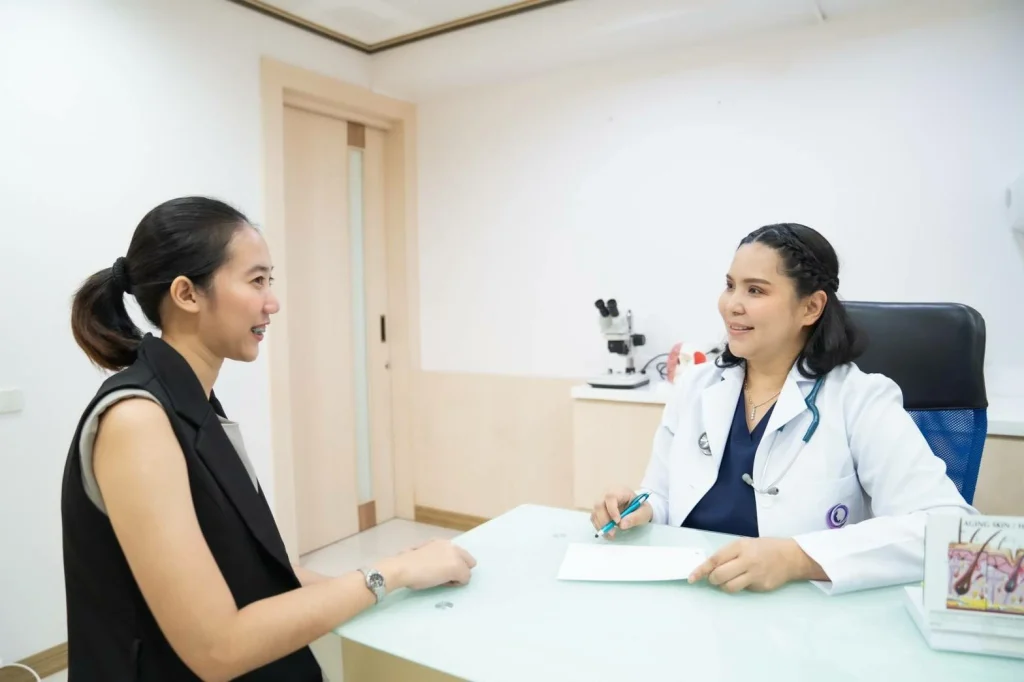Recommended nail treatment clinic near Pattaya and in Chonburi.
Welcome to our nail clinic near Chonburi, Pattaya! The best. We provide the best nail care to our customers. There is a team of doctors who specialize in treating or recommending nail treatment procedures. Highly skilled and experienced We only use quality products and equipment that are safe and meet international standards. so that customers have confidence in their treatment feel relaxed while being treated
Ingrown toenail disease
Ingrown toenail disease, also known as onychocryptosis, is a common condition where the edge or corner of a toenail grows into the surrounding skin, causing pain, swelling, and infection. The condition can affect anyone but is more common in adults and adolescents. It usually affects the big toe, but it can also affect other toes.
Causes of ingrown toenails
Ingrown toenails occur when the edge or corner of the toenail grows into the skin surrounding the nail, causing pain, redness, and swelling. Some common causes of ingrown toenails include:
1. Improper toenail trimming
Nails that are trimmed too short or rounded at the edges can encourage the nail to grow into the skin.
2. Tight or poorly fitting shoes
Shoes that are too tight or narrow in the toe box can put pressure on the toenails, causing them to grow into the skin.
3. Injury
Trauma to the toe, such as stubbing or dropping something heavy on it, can cause the nail to grow abnormally and become ingrown.
4. Genetics
Some people may be more prone to ingrown toenails due to inherited factors, such as the shape of their toes or the thickness of their nails.
5. Fungal infections
Fungal infections of the nail or surrounding skin can cause the nail to thicken and become more likely to grow into the skin.
6. Poor foot hygiene
Failure to keep the feet clean and dry can lead to bacterial infections that can cause the skin around the nail to become inflamed and infected, making it more likely for the nail to become ingrown.
What are the symptoms of ingrown toenails?
Ingrown toenails occur when the edge of the toenail grows into the surrounding skin, causing pain and discomfort. Some common symptoms of ingrown toenails include:
1. Pain and tenderness
The affected toe may feel painful or tender to the touch, especially when pressure is applied.
2. Swelling
The area around the ingrown toenail may become swollen and inflamed.
3. Redness
The skin around the ingrown toenail may turn red and feel warm to the touch.
4. Infection
If the ingrown toenail is left untreated, it can lead to an infection, which may cause pus to develop and the toe to feel more painful.
5. Difficulty walking
Ingrown toenails can make it difficult to wear shoes or walk comfortably, especially if the toe is swollen or painful.
If you are experiencing any of these symptoms, it is important to seek medical attention to prevent further complications.
Infected nail disease
An infected nail disease can refer to a variety of conditions that affect the nails, including fungal infections, bacterial infections, and viral infections. Here are some common types of infected nail diseases:
1. Fungal nail infection
This occurs when a type of fungus called dermatophyte grows on the nail. It can cause the nail to become thick, discolored, and brittle.
2. Bacterial nail infection
This is a rare condition that occurs when bacteria infect the nail bed or surrounding skin. It can cause the nail to become discolored, painful, and swollen.
3. Paronychia
This is a type of bacterial nail infection that affects the skin around the nail. It can cause redness, swelling, and pain, and may result in pus-filled blisters.
4. Herpetic whitlow
This is a viral infection that affects the fingers and toes. It can cause small blisters to form on the nail or surrounding skin, which may be painful and itchy.
Treatment for infected nail diseases depends on the specific condition and may include antifungal or antibiotic medications, topical creams or ointments, or surgical intervention in severe cases. It’s important to seek medical attention if you suspect that you have an infected nail disease, as some conditions can lead to serious complications if left untreated.
Symptoms of fungal nails What are the symptoms?
Fungal nail infection, also known as onychomycosis, is a common condition that affects the nails, particularly those on the toes. Here are some common symptoms of fungal nails:
- Thickened nails Fungal nail infections can cause the nail to become thicker than usual, making it difficult to trim.
- Discolored nails The nail may become yellow, brown, or white and may have dark spots or streaks.
- Crumbly or brittle nails Fungal nail infections can cause the nail to become brittle or crumbly, making it more likely to break or split.
- Distorted nails The nail may become distorted in shape or texture, and may become separated from the nail bed.
- Foul odor Fungal nail infections can cause the nail to emit a foul odor, particularly when the infection is severe.
- Pain or discomfort The infected nail may be painful or tender to the touch, particularly when pressure is applied to the nail or surrounding skin.
If you suspect that you have a fungal nail infection, it’s important to seek medical attention. Treatment options include antifungal medications, topical creams or ointments, or in severe cases, removal of the nail.
Curved nail disease
Curved nail disease, also known as nail clubbing, is a condition in which the nails become thickened and curved, resembling the shape of a drumstick. Here are some common symptoms and causes of curved nail disease:
Symptoms Curved nail disease:
- Thickened nails The nails may become thicker than usual, particularly at the base of the nail.
- Curved nails The nails may curve downwards, resembling the shape of a spoon or drumstick.
- Softening of the nail bed The nail bed may become soft to the touch, and the skin around the nail may appear swollen or red.
- Changes in the nail’s angle The angle between the nail and the finger may become wider than usual.
Causes Curved nail disease:
1. Lung or heart disease
Curved nail disease is often associated with lung or heart conditions, such as chronic obstructive pulmonary disease (COPD) or congenital heart disease.
2. Inflammatory bowel disease
Curved nail disease may also be associated with inflammatory bowel disease (IBD), such as Crohn’s disease or ulcerative colitis.
3. Liver disease
Certain liver conditions, such as cirrhosis, may also be associated with curved nail disease.
4. Genetics
In some cases, curved nail disease may be inherited as a genetic condition.
Treatment for curved nail disease depends on the underlying cause. In some cases, addressing the underlying condition may lead to improvement in nail symptoms. In other cases, treatment may focus on managing symptoms, such as pain or discomfort. If you suspect that you have curved nail disease, it’s important to seek medical attention to determine the underlying cause and appropriate treatment.
If you have treated nails What are the dangers of making a mistake?
If you have treated nails, making a mistake during treatment can have potential dangers and risks. Here are some examples:
1. Incomplete treatment
If you do not complete the full course of treatment for a nail condition, such as a fungal nail infection, the infection may not be fully eliminated and can return.
2. Overuse of medication
Overusing medication or using it for an extended period of time can lead to side effects or toxicity, particularly with oral medications.
3. Incorrect application
Applying topical medications incorrectly can lead to ineffective treatment, or may cause skin irritation or damage to the surrounding skin.
4. Injury or trauma
If you are treating a nail condition, you may be more susceptible to injury or trauma to the affected nail. This can result in pain, bleeding, or infection.
5. Self-diagnosis
If you attempt to treat a nail condition without a proper diagnosis from a healthcare professional, you may be treating the wrong condition or using an inappropriate treatment.
It is important to follow the instructions provided by your healthcare professional or the medication label when treating a nail condition. If you experience any unexpected side effects or worsening of symptoms, you should seek medical attention immediately. Additionally, if you are unsure of the proper treatment for a nail condition, it is important to seek a diagnosis from a healthcare professional before attempting any treatment.
Hair disease
Hair diseases are conditions that affect the scalp and hair follicles, resulting in changes in the appearance and texture of hair. Here are some common hair diseases:
1. Alopecia
Alopecia refers to hair loss, which can occur in patches or across the entire scalp. There are several types of alopecia, including alopecia areata, which is an autoimmune disorder, and androgenic alopecia, which is a hereditary condition commonly known as male or female pattern baldness.
2. Dandruff
Dandruff is a common scalp condition that causes flakes of skin to shed from the scalp. It is often accompanied by itching and irritation.
3. Scalp psoriasis
Psoriasis is a chronic autoimmune condition that can affect the scalp, causing red, scaly patches on the skin. This can lead to hair loss in severe cases.
4. Tinea capitis
Tinea capitis is a fungal infection of the scalp that can cause scaling, itching, and hair loss.
5. Trichotillomania
Trichotillomania is a psychological condition characterized by a compulsive urge to pull out one’s own hair, resulting in hair loss and bald patches.
Treatment for hair diseases depends on the specific condition and may include medications, topical treatments, or lifestyle changes. In some cases, hair loss may be irreversible, and hair restoration procedures such as hair transplant surgery may be necessary. It’s important to seek medical attention if you notice any changes in the appearance or texture of your hair, as early treatment may lead to better outcomes.
Skin disease
Skin diseases are conditions that affect the skin, leading to changes in its appearance, texture, and function. Here are some common skin diseases:
1. Acne
Acne is a common skin condition that occurs when hair follicles become clogged with oil and dead skin cells, leading to the formation of pimples, blackheads, and whiteheads.
2. Eczema
Eczema, also known as atopic dermatitis, is a chronic inflammatory skin condition that causes dry, itchy, and inflamed skin.
3. Psoriasis
Psoriasis is a chronic autoimmune condition that causes the rapid buildup of skin cells, leading to red, scaly patches on the skin.
4. Rosacea
Rosacea is a chronic skin condition that causes redness and swelling of the face, often accompanied by small, pus-filled bumps.
5. Skin cancer
Skin cancer is a type of cancer that develops in the skin cells, typically caused by exposure to UV radiation from the sun or other sources.
6. Dermatitis
Dermatitis is a broad term that refers to inflammation of the skin. It can be caused by a variety of factors, including allergies, irritants, and infections.
Treatment for skin diseases depends on the specific condition and may include medications, topical treatments, or lifestyle changes. It’s important to seek medical attention if you notice any changes in the appearance or texture of your skin, as early treatment may lead to better outcomes. Additionally, protecting your skin from sun damage and avoiding exposure to irritants or allergens can help prevent some skin diseases from developing.
Advantages of nail treatment at SevenPlus Clinic and D’secert Clinic
Nail treatment at SevenPlus Clinic and D’secert Clinic can offer several advantages, including
1. Professional care
Both clinics offer professional and experienced medical staff who specialize in the treatment of nail conditions. This ensures that patients receive the highest quality care and treatment for their specific needs.
2. State-of-the-art equipment
Both clinics are equipped with the latest technology and equipment to provide the most effective and efficient treatment for nail conditions.
3. Comprehensive treatment options
SevenPlus Clinic and D’secert Clinic offer a range of treatment options for various nail conditions, including fungal infections, ingrown toenails, and curved nails. This allows patients to receive personalized treatment plans that are tailored to their specific condition and needs.
4. Comfortable environment
Both clinics provide a comfortable and welcoming environment for patients, with state-of-the-art facilities and amenities to ensure a pleasant experience during treatment.
5. Follow-up care
Both clinics offer follow-up care and support for patients to ensure that their treatment is effective and that they are able to maintain healthy nails in the long-term.
Overall, nail treatment at SevenPlus Clinic and D’secert Clinic can provide patients with effective and personalized care for a range of nail conditions, ensuring the best possible outcomes and long-term nail health.
Dr. Marinya Pongputphan
Education of Dr. Marinya Pongpudpunth
- Hair Restoration Training, Korea (2015)
- Thai Board of Dermatology, Ramathibodi Hospital (2013)
- Board of Dematopathology, Boston University, USA (2009)
- Master of Science in Dermatology, Boston University, USA (2006)
- Doctor of Medicine, Mahidol University (2001)
- Nail surgery training
- Laser expert training
- Hair expert training
- Boton university usa
Work experience of Dr. Marinya
Pongpudpunth
- Dermatologist Mae Fah Luang Hospital
- Dermatologist Ramathibodi Hospital
- Dermatologist, Samitivej Hospital
- Dermatologist, Bangkok Hospital
Treatment of nail disease near Chonburi, Pattaya must be done at SevenPlus Clinic and D’secert Clinic.
Both clinics offer a range of treatments for nail diseases, such as medication, laser therapy, and nail surgery, depending on the severity of the condition. You can book an appointment with a dermatologist at either clinic through their website or by calling their hotline. It is recommended to consult with a dermatologist for proper diagnosis and treatment of nail diseases to prevent any further complications

